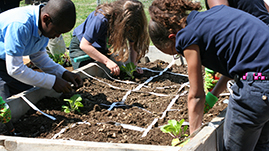Teachers' Domain - Digital Media for the Classroom and Professional Development
User: Preview



Many modern gardeners as well as farmers strive to achieve sustainability: keeping the natural environment healthy and balanced so that it will sustain food production and support the organisms that live in the ecosystem.
Sustainable gardening practices are not new; they have been part of agriculture since its beginnings more than 10,000 years ago. But in the United States, the term “sustainable agriculture” was first defined by the U.S. Congress in the Food, Agriculture, Conservation, and Trade Act of 1990, known as FACTA.
Here is the definition from that document:
The term sustainable agriculture means an integrated system of plant and animal production practices having a site-specific application that will, over the long term: satisfy human food and fiber needs; enhance environmental quality and the natural resource base upon which the agricultural economy depends; make the most efficient use of nonrenewable resources and on-farm resources and integrate, where appropriate, natural biological cycles and controls; sustain the economic viability of farms operations; and enhance the quality of life for farmers and society as a whole.
Few people would disagree with this definition of sustainability. But as the phrase “site-specific application” suggests, it’s not always easy to determine which specific practices are sustainable, and how they might vary from situation to situation.
For this reason, creating sustainable gardens requires using higher-level reasoning skills such as cause and effect and prediction to analyze the many factors that influence an ecosystem both in the short and the long term.
These factors might include the use of resources such as soil, compost, and fertilizers and the effect of gardening practices on the ecosystem. For example, thoughtful gardeners might examine the benefits and drawbacks of tilling the garden plot. This widely used practice has practical benefits such as reducing weeds and loosening the soil for planting. But it also can destroy helpful worms and microbes and reduce the amount of water and nutrients in the soil. After weighing the options, gardeners may choose zero tilling instead, an alternative that leaves the soil undisturbed and creates a better environment for wildlife.
Sustainability also requires the recognition that garden ecosystems are part of larger ecosystems and biomes. What gardeners do in their little plot of land can harm or help resources and organisms far beyond their backyard fences.
Let’s say that a gardener uses pesticides and herbicides to kill insects and weeds in the garden. Those chemicals seep into the water table and end up in the watershed, the area of land that drains into a river system. Add those pesticides and herbicides to the ones used by other gardeners and farmers, and the result is an overall reduction in water quality. To achieve sustainability not only in the garden but also in the environment as a whole, gardeners may look to other practices, such as introducing predators like ladybugs that eat harmful bugs and using mulch or compost to discourage weeds.
 Loading Standards
Loading Standards